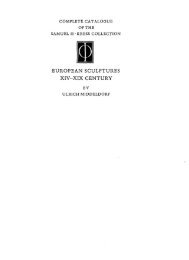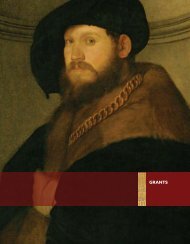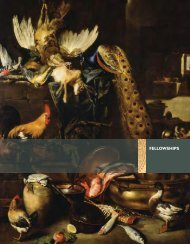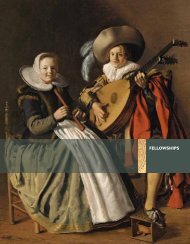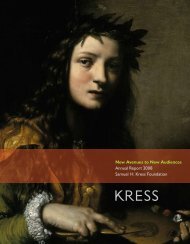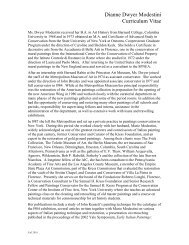The Campus Art Museum - Samuel H. Kress Foundation
The Campus Art Museum - Samuel H. Kress Foundation
The Campus Art Museum - Samuel H. Kress Foundation
You also want an ePaper? Increase the reach of your titles
YUMPU automatically turns print PDFs into web optimized ePapers that Google loves.
artists to the museum’s collections, and recognized the value of the Frank Lloyd<br />
Wright Usonian House, which she purchased, restored, and bequeathed to the<br />
museum. She appeared to have unfailing energy and vision. One person can make a<br />
large difference in a museum and have a lasting legacy, as will be discussed later.<br />
Oberlin is a small private college situated in a small rural town. It might<br />
appear relatively easier for it to have an arts-centric culture and to cater to a<br />
particular kind of student than a large university. Several of the large public<br />
universities in the study, however, also appear to be institutions where the arts<br />
have been valued and supported over time. In these cases, specific people have<br />
again helped to develop the climate for this support. For example, Chancellor<br />
Franklin P. Murphy (1951-1960) helped make the arts a vital part of schooling at KU<br />
through creating endowed travel funds to bring artists to campus as well as to send<br />
local art faculty elsewhere for conferences and research. As described by a curator,<br />
He also invested heavily in the history of art library and left many books to<br />
us…. He was on the national board of the Getty and things like that, so he was<br />
very well connected, very farsighted…. He was totally intoxicated with art and<br />
understood its significance within the university context.<br />
<strong>The</strong> chancellor’s work was not done in a vacuum. Interviewees mentioned<br />
Professor Marilyn Stokstad who got funding and worked to integrate the Spencer<br />
into undergraduate courses at the university following the opening of the museum<br />
in 1978. According to a curator, “We had a string of people who were smart<br />
educators before they were even called educators…. We’ve had some important<br />
people early on.”<br />
At IU, credit for helping establish a culture of supporting the arts goes to<br />
Herman Wells who was a student, faculty member, president from 1937 to 1962,<br />
and finally chancellor at IU. He was instrumental in the creation of the art museum,<br />
the school of music, and the opera house, among other things:<br />
<strong>Art</strong> was a central part of his commitment to students. He believed that they<br />
needed to have art in their lives, that it would make a difference for them, so<br />
you see art in public spaces around campus, very high quality art… He was…<br />
one of the great visionaries for this campus and its commitment to art.… When<br />
he became president... he wanted IU to be a place where students from small<br />
towns in Indiana could experience the world and he also wanted the world to<br />
be part of this university…. He did a lot of things that were very controversial,<br />
but he did them with a grace and ease and absolute shrewdness that was<br />
remarkable and effective…. Thomas Hart Benton’s murals are sitting in a barn<br />
or warehouse somewhere and he said, “We’d like to have those.” He recognized<br />
the importance of art in the human spirit. (administrator)<br />
IU has continued to build on Herman Wells’ commitment to art, as noted by IUAM<br />
personnel: “<strong>The</strong> whole profile that [IU has] defined for itself is strength in the arts and<br />
humanities—the school of music, the value and treasures in the library…, the theater<br />
program…, all of those in aggregate are the great strength that IU prides itself on.”<br />
Supportive <strong>Campus</strong> Cultures and Structures<br />
9



